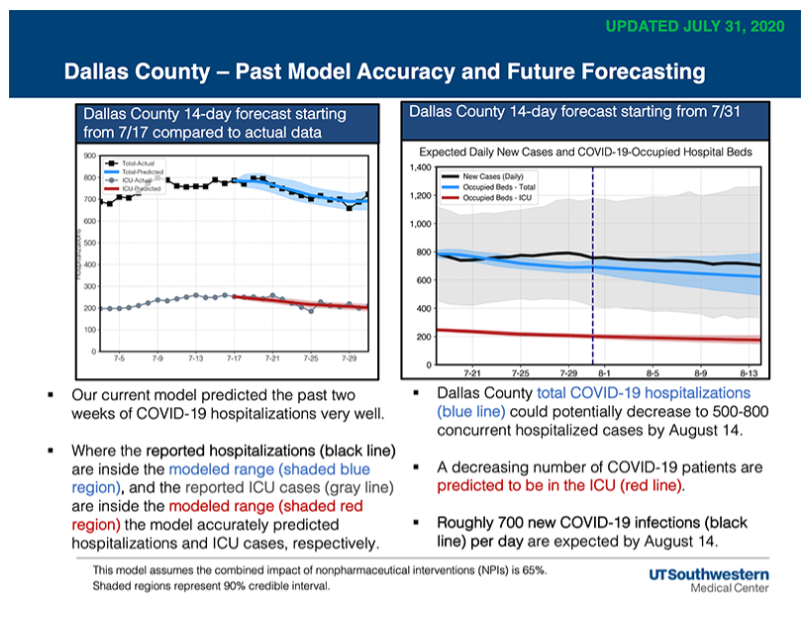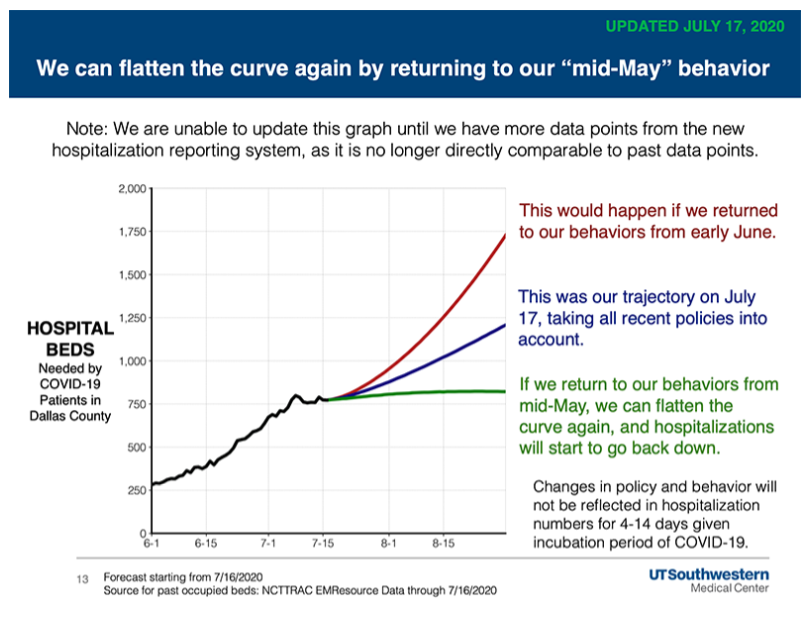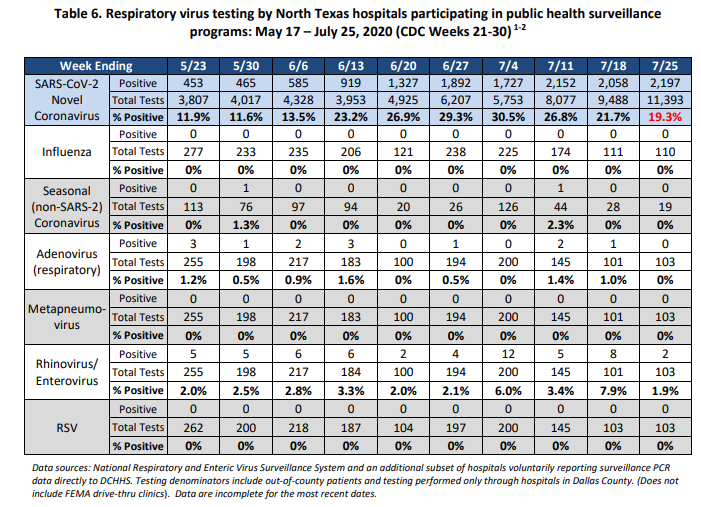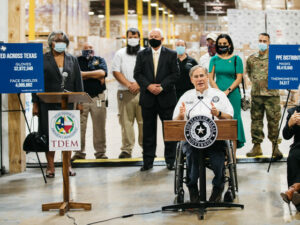University of Texas Researchers Estimate Likelihood of COVID Encounters at Schools
The big conversation around COVID-19 right now is schools – when should we send kids to school, and how safe will it be when they get there? We look at some of the information for that in today’s bullet points.
- University of Texas researchers estimate likelihood of COVID encounters at schools;
- Dallas County reports 31 dead from COVID-19 Tuesday;
- Abbott provides update on PPE supply for schools.
University of Texas Researchers Estimate Likelihood of COVID Encounters at Schools
How likely is it that someone with COVID-19 will show up to school in the first week? That depends on the scope of the outbreak in the community where the school is, and the size of the school, University of Texas at Austin researchers found.
The researchers found that right now, more than 80% of Americans live in a county where the infection rate is high enough that at least one person infected with the novel coronavirus would likely show up the first week of school if the school had 500 students and staff.
In Dallas County, if school were to start today, four infected people would likely show up at a school with 500 or more, and nine in a school of 1,000 or more. In nearby Collin County, where the infection rate in the general population is lower, a school of 500 would expect at least one person, and a school of 1,000 would expect three. Tarrant County would expect four in a school of 500, and eight in a school of 1,000. In Denton County, a school of 500 would expect three, and a school of 1,000 would expect six.
Dallas, Denton, and Tarrant counties begin risking an infected person showing up at the schools with 100 students and staff, but Collin County has little risk at that level, the estimate showed.
Dallas County Reports 31 Dead from COVID-19 Tuesday
Dallas County health officials reported 31 new deaths Tuesday, bringing the total confirmed deaths from COVID-19 to 722.
An additional 641 confirmed cases were also reported, bringing the total to 52,131.
Among the dead are:
- A man in his 20s who was a resident of the City of Dallas. He had been critically ill in an area hospital and had underlying high-risk health conditions.
- A man in his 30s who was a resident of the City of Dallas. He expired in an area hospital ED, and did not have underlying high-risk health conditions.
- A man in his 30s who was a resident of the City of Dallas. He had been hospitalized and did not have underlying high-risk health conditions.
- A man in his 40s who was a resident of the City of Garland. He had been critically ill in an area hospital and had underlying high-risk health conditions.
- A man in his 50s who was a resident of the City of Grand Prairie. He had been critically ill in an area hospital and had underlying high-risk health conditions.
- A man in his 50s who was a resident of the City of Dallas. He had been critically ill in an area hospital and had underlying high-risk health conditions.
- A man in his 60s who was a resident of the City of Dallas. He had been critically ill in an area hospital and had underlying high-risk health conditions.
- A woman in her 60s who was a resident of the City of Cedar Hill. She had been hospitalized and had underlying high-risk health conditions.
- A man in his 60s who was a resident of the City of Dallas. He had been critically ill in an area hospital and had underlying high-risk health conditions.
- A man in his 60’s who was a resident of the City of Mesquite. He had been critically ill in an area hospital and had underlying high risk health conditions.
- A man in his 60s who was a resident of the City of Cockrell Hill. He had been critically ill in an area hospital and had underlying high-risk health conditions.
- A man in his 60s who was a resident of the City of Irving. He had been critically ill in an area hospital and had underlying high-risk health conditions.
- A woman in her 60s who was a resident of the City of Dallas. She had been critically ill in an area hospital and had underlying high-risk health conditions.
- A woman in her 60s who was a resident of the City of Mesquite. She had been hospitalized and had underlying high-risk health conditions.
- A woman in her 60s who was a resident of the City of Dallas. She expired in an area hospital ED, and had underlying high-risk health conditions.
- A man in his 60s who was a resident of the City of Dallas. He had been critically ill in an area hospital and had underlying high-risk health conditions.
- A woman in her 70s who was a resident of the City of Dallas. She had been critically ill in an area hospital and had underlying high-risk health conditions.
- A man in his 70s who was a resident of the City of Garland. He had been hospitalized and had underlying high-risk health conditions.
- A woman in her 80s who was a resident of the City of Rowlett. She had been hospitalized and had underlying high-risk health conditions.
- A woman in her 80s who was a resident of the City of Rowlett. She had been hospitalized and had underlying high-risk health conditions
- A woman in her 80s who was a resident of the City of Dallas. She had been critically ill in an area hospital and had underlying high-risk health conditions.
- A woman in her 90s who was a resident of the City of Dallas. She had been critically ill in an area hospital and had underlying high-risk health conditions.
Long-term care facilities continue to account for a third of all COVID-19 deaths, including:
- A man in his 60s who was a resident of a long-term care facility in the City of DeSoto. He had been hospitalized, and had underlying high risk health conditions.
- A woman in her 70s who was a resident of a long-term care facility in the City of Dallas. She expired in the facility. A woman in her 70’s who was a resident of a long-term care facility in the City of Mesquite. She had been critically ill in an area hospital and did not have underlying high-risk health conditions.
- A woman in her 80s who was a resident of a long-term care facility in the City of Dallas. She expired in the facility and did not have underlying high-risk health conditions.
- A man in his 80s who was a resident of a long-term care facility in the City of Cedar Hill. He had been hospitalized.
- A woman in her 80s who was a resident of a long-term care facility in the City of Dallas. She expired in the facility.
- A man in his 80’s who was a resident of a long-term care facility in the City of Dallas. He had been hospitalized and had underlying high-risk health conditions.
- A woman in her 90s who was a resident of a long-term care facility in the City of Dallas. She expired in the facility and had underlying high-risk health conditions.
- A woman in her 90s who was a resident of a long-term care facility in the City of Dallas. She expired in the facility and did not have underlying high-risk health conditions.
The county said that the number of COVID-19 hospitalizations Monday was 655 patients. Emergency room visits for COVID-19 symptoms also remain high, representing about 24% of all ER visits, according to information reported to the North Central Texas Trauma Regional Advisory Council.

UT Southwestern’s latest forecast projects that by August 14, Dallas County hospitals could see concurrent hospitalizations from COVID-19 decrease to between 500 and 800 cases. As previously reported, there is a gap in hospitalization data due to a change in the reporting system, but the researchers expect that if hospitalizations (which are a lagging indicator) follow the most recent case counts, the area could see a reduction in hospitalizations over the next few weeks.

In the county’s August 4 aggregate report, most confirmed cases continue to be between the ages of 18 and 60, with the 18-40 age group accounting for 46% of the cases, and the 41-64 age group accounting for another 35% of the total cases.

Over 2,340 children under 18 years of age have been diagnosed with COVID-19 since July 1. During this timeframe, 61 children have been hospitalized for COVID-19. Of all confirmed cases requiring hospitalization to date, more than two-thirds have been under 65 years of age.
Close contact or community transmission continues to be the biggest risk factor for contracting COVID-19, accounting for 92% of all cases. Being incarcerated in a federal prison, living in a long-term care facility or being incarcerated in the county jail are a distant second, third, and fourth, at 2.6%, 2.3% and 1.2%, respectively.
Of the testing done, positive cases accounted for 19.3% as of July 25, with 2,197 positives coming from 11,393 tests. Testing and positive test results of COVID-19 far outpaces any other respiratory virus – even if you combine them all.

Thirteen percent of all cases ended up hospitalized – 21% ended up in intensive care, and 11% ended up on a ventilator.
In a city-by-city breakdown, Dallas still comes in with the highest number of cases – 27,782, or 53.3%. Highland Park has 41 cases so far, and University Park has 78 (up from 75).
Abbott Provides Update on PPE Supply for Schools
Gov. Greg Abbott visited the Texas Division of Emergency Management warehouse in San Antonio Tuesday to talk about how much personal protective equipment – or PPE – is available for Texas school districts this year.

Abbott said that the state will continue to purchase and distribute PPE to school districts this year at no cost to the districts.
“Health and safety remain our top priority as we approach the upcoming school year,” said Abbott. “To meet that priority, the State of Texas is purchasing and distributing vast amounts of PPE to Texas school districts. As local school boards make determinations on how and when they choose to open schools, the state is working to help ensure that there will be a strong supply of PPE waiting for them to keep students, teachers, and staff safe.”
The governor said that the state has already distributed more than 54 million masks, more than 567,000 gallons of hand sanitizer, 24,017 thermometers, and a little more than half a million face shields to school districts.
Abbott also announced that President Trump extended federal funding for the Texas National Guard’s efforts in helping the state combat COVID-19, with full funding continuing through the end of the year.
“The Texas National Guard plays a vital role in our response and recovery efforts, and I thank President Trump for extending this federal funding,” said Abbott. “The Lone Star State remains vigilant in our efforts to combat the spread of COVID-19 and we will continue to work alongside our federal partners to keep Texans safe.”
Abbott activated the Texas National Guard in March, and the guard has assisted in field testing, decontaminating facilities, providing regional support of storage and distribution of PPE, and more.










